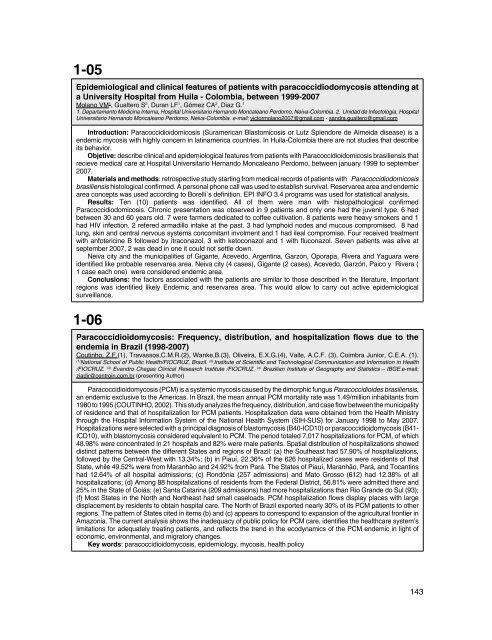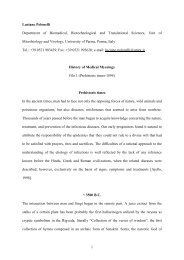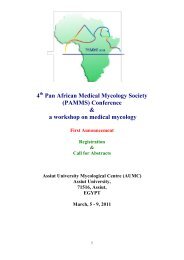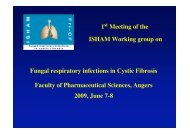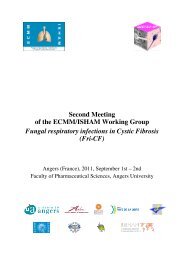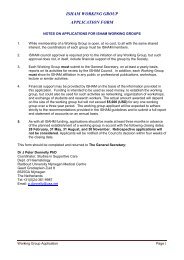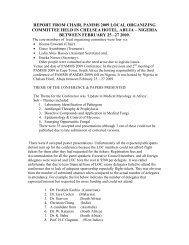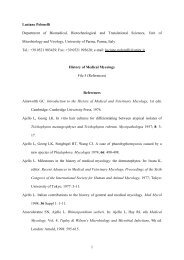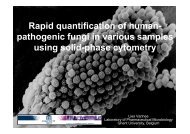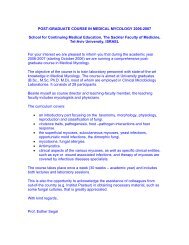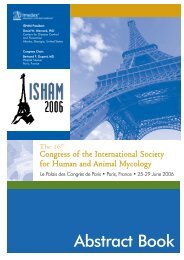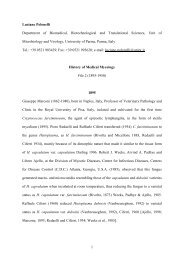Memoria CD.indd - ISHAM
Memoria CD.indd - ISHAM
Memoria CD.indd - ISHAM
You also want an ePaper? Increase the reach of your titles
YUMPU automatically turns print PDFs into web optimized ePapers that Google loves.
1-05Epidemiological and clinical features of patients with paracoccidiodomycosis attending ata University Hospital from Huila - Colombia, between 1999-2007Molano VM 1 , Gualtero S 2 , Duran LF 1 , Gómez CA 2 , Diaz G. 11. Departamento Medicina Interna, Hospital Universitario Hernando Moncaleano Perdomo, Neiva-Colombia. 2. Unidad de Infectologia, HospitalUniversitario Hernando Moncaleano Perdomo, Neiva-Colombia. e-mail: victormolano2007@gmail.com - sandra.gualtero@gmail.comIntroduction: Paracoccidioidomicosis (Suramerican Blastomicosis or Lutz Splendore de Almeida disease) is aendemic mycosis with highly concern in latinamerica countries. In Huila-Colombia there are not studies that describeits behavior.Objetive: describe clinical and epidemiological features from patients with Paracoccidioidomicosis brasiliensis thatrecieve medical care at Hospital Universitario Hernando Moncaleano Perdomo, between january 1999 to september2007.Materials and methods: retrospective study starting from medical records of patients with Paracoccidiodomicosisbrasiliensis histological confirmed. A personal phone call was used to establish survival. Reservarea area and endemicarea concepts was used according to Borelli´s definition. EPI INFO 3.4 programs was used for statistical analysis.Results: Ten (10) patients was identified. All of them were man with histopathological confirmedParacoccidiodomicosis. Chronic presentation was observed in 9 patients and only one had the juvenil type. 6 hadbetween 30 and 60 years old. 7 were farmers dedicated to coffee cultivation. 8 patients were heavy smokers and 1had HIV infection. 2 refered armadillo intake at the past. 3 had lymphoid nodes and mucous compromised. 8 hadlung, skin and central nervous systems concomitant involment and 1 had ileal compromise. Four received treatmentwith anfotericine B followed by itraconazol, 3 with ketoconazol and 1 with fluconazol. Seven patients was alive atseptember 2007, 2 was dead in one it could not settle down.Neiva city and the municipalities of Gigante, Acevedo, Argentina, Garzon, Oporapa, Rivera and Yaguara wereidentified like probable reservarea area. Neiva city (4 cases), Gigante (2 cases), Acevedo, Garzón, Paico y Rivera (1 case each one) were considered endemic area.Conclusions: the factors associated with the patients are similar to those described in the literature. Importantregions was identified likely Endemic and reservarea area. This would allow to carry out active epidemiologicalsurveillance.1-06Paracoccidioidomycosis: Frequency, distribution, and hospitalization flows due to theendemia in Brazil (1998-2007)Coutinho, Z.F.(1), Travassos,C.M.R.(2), Wanke,B.(3), Oliveira, E.X.G.(4), Valle, A.C.F. (3), Coimbra Junior, C.E.A. (1).(1)National School of Public Health/FIOCRUZ, Brazil. (2) Institute of Scientific and Technological Communication and Information in Health/FIOCRUZ. (3) Evandro Chagas Clinical Research Institute /FIOCRUZ. (4) Brazilian Institute of Geography and Statistics – IBGE.e-mail:ziadir@centroin.com.br (presenting Author)Paracoccidioidomycosis (PCM) is a systemic mycosis caused by the dimorphic fungus Paracoccidioides brasiliensis,an endemic exclusive to the Americas. In Brazil, the mean annual PCM mortality rate was 1.49/million inhabitants from1980 to 1995 (COUTINHO, 2002). This study analyzes the frequency, distribution, and case flow between the municipalityof residence and that of hospitalization for PCM patients. Hospitalization data were obtained from the Health Ministrythrough the Hospital Information System of the National Health System (SIH-SUS) for January 1998 to May 2007.Hospitalizations were selected with a principal diagnosis of blastomycosis (B40-I<strong>CD</strong>10) or paracoccidioidomycosis (B41-I<strong>CD</strong>10), with blastomycosis considered equivalent to PCM. The period totaled 7,017 hospitalizations for PCM, of which48.98% were concentrated in 21 hospitals and 82% were male patients. Spatial distribution of hospitalizations showeddistinct patterns between the different States and regions of Brazil: (a) the Southeast had 57.90% of hospitalizations,followed by the Central-West with 13.34%; (b) in Piauí, 22.36% of the 626 hospitalized cases were residents of thatState, while 49.52% were from Maranhão and 24.92% from Pará. The States of Piauí, Maranhão, Pará, and Tocantinshad 12.64% of all hospital admissions; (c) Rondônia (257 admissions) and Mato Grosso (612) had 12.38% of allhospitalizations; (d) Among 88 hospitalizations of residents from the Federal District, 56.81% were admitted there and25% in the State of Goiás; (e) Santa Catarina (209 admissions) had more hospitalizations than Rio Grande do Sul (93);(f) Most States in the North and Northeast had small caseloads. PCM hospitalization flows display places with largedisplacement by residents to obtain hospital care. The North of Brazil exported nearly 30% of its PCM patients to otherregions. The pattern of States cited in items (b) and (c) appears to correspond to expansion of the agricultural frontier inAmazonia. The current analysis shows the inadequacy of public policy for PCM care, identifies the healthcare system’slimitations for adequately treating patients, and reflects the trend in the ecodynamics of the PCM endemic in light ofeconomic, environmental, and migratory changes.Key words: paracoccidioidomycosis, epidemiology, mycosis, health policy143


